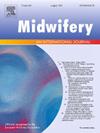Determinants of low birth weight among newborns of women from a Middle Eastern Country: a retrospective case - control study
IF 2.5
3区 医学
Q1 NURSING
引用次数: 0
Abstract
Background
Low birth weight (LBW) is the leading cause of inpatient morbidity for newborns under seven days of age and it is a major determinants of neonate’s long-term health.
Purpose
To examine determinants of low birth weight among newborns born to women from a Middle Eastern Country.
Methods
In this retrospective matched (1:1) case-control study, 414 participants were included from five major tertiary hospitals in Oman. A standardized report form was developed by the study principal investigator on the basis of a literature review on determinants of low birth weight. A Chi square test and a binary logistic regression were used to analyze the outcome of LBW (case versus control) and its determinants.
Results
Between January to June 2023, descriptive statistics showed that 8.3 % of newborns were born with LWB. Logistic regression results showed that total weight gain (β = -0.004, p < 0.05), baby gender (β = 0.685, p < 0.05), presence of IUGR (β = 1.82, p < 0.05), and hemoglobin level at delivery (β = -0.010, p < 0.05) were the only significant determinants of low birth weight.
Conclusion
According to our study, LBW is significantly determined by maternal weight gain, maternal hemoglobin level at delivery, baby’s gender and IUGR. Midwives and antenatal healthcare providers are recommended to closely monitor hemoglobin levels and total weight gain throughout pregnancy. Furthermore, midwives are encouraged to adopt enhanced prenatal screening protocols that incorporate gender-specific risk assessments and more rigorous monitoring of signs of IUGR to mitigate the adverse outcomes associated with LBW, thus improving neonatal health outcomes and reducing LBW burden on health systems.
中东国家妇女新生儿低出生体重的决定因素:一项回顾性病例对照研究
背景:低出生体重(LBW)是7天以下新生儿住院发病率的主要原因,也是新生儿长期健康的主要决定因素。目的研究中东国家妇女所生新生儿低出生体重的决定因素。方法本回顾性匹配(1:1)病例对照研究纳入了来自阿曼5家三级医院的414名受试者。该研究的主要研究者在对低出生体重决定因素的文献回顾的基础上制定了一份标准化的报告表格。使用卡方检验和二元逻辑回归分析LBW(病例与对照组)的结果及其决定因素。结果2023年1 - 6月,描述性统计显示8.3%的新生儿出生时患有LWB。Logistic回归结果显示,总增重(β = -0.004, p <;0.05),婴儿性别(β = 0.685, p <;0.05), IUGR的存在(β = 1.82, p <;0.05),分娩时血红蛋白水平(β = -0.010, p <;0.05)是低出生体重的唯一显著决定因素。结论产妇体重增加、分娩时产妇血红蛋白水平、胎儿性别和IUGR对分娩体重有显著影响。建议助产士和产前保健提供者密切监测血红蛋白水平和孕期总体重增加。此外,鼓励助产士采用加强的产前筛查方案,其中包括针对性别的风险评估和更严格的IUGR迹象监测,以减轻与LBW相关的不良后果,从而改善新生儿健康结局,减少LBW对卫生系统的负担。
本文章由计算机程序翻译,如有差异,请以英文原文为准。
求助全文
约1分钟内获得全文
求助全文
来源期刊

Midwifery
医学-护理
CiteScore
4.50
自引率
7.40%
发文量
221
审稿时长
13.4 weeks
期刊介绍:
Midwifery publishes the latest peer reviewed international research to inform the safety, quality, outcomes and experiences of pregnancy, birth and maternity care for childbearing women, their babies and families. The journal’s publications support midwives and maternity care providers to explore and develop their knowledge, skills and attitudes informed by best available evidence.
Midwifery provides an international, interdisciplinary forum for the publication, dissemination and discussion of advances in evidence, controversies and current research, and promotes continuing education through publication of systematic and other scholarly reviews and updates. Midwifery articles cover the cultural, clinical, psycho-social, sociological, epidemiological, education, managerial, workforce, organizational and technological areas of practice in preconception, maternal and infant care.
The journal welcomes the highest quality scholarly research that employs rigorous methodology. Midwifery is a leading international journal in midwifery and maternal health with a current impact factor of 1.861 (© Thomson Reuters Journal Citation Reports 2016) and employs a double-blind peer review process.
 求助内容:
求助内容: 应助结果提醒方式:
应助结果提醒方式:


